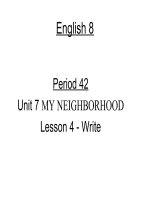GIÁO ÁN ANH 6 UNIT 4 MỚI (3 CÔT)
Bạn đang xem bản rút gọn của tài liệu. Xem và tải ngay bản đầy đủ của tài liệu tại đây (680.08 KB, 49 trang )
Planning date: 6/11/2018
Period 27
UNIT 4 : MY NEIGHBORHOOD
GETTING STARTED
I. Objectives
This lesson will present the vocabulary and grammar items to be learned. Ss
then practice listening and speaking with the lexical items related to the topic "My
neighbourhood".
II. Language focus:
- Vocab: words about neighbourhood.
- Grammar: comparative adjectives.
III. Teaching aids
- Text book
- Board, chalk,...
- A cassette and an audio compact disk.
IV. Procedure
Steps
Learning activities
Modes
Warm up
Kim’s game
- T gets Ss to look through the picture and
5ms
Whole class
remember some things in it.
Getting
-Teacher sets the scene by asking Ss about the
picture
started
Whole class
Where are Nick , Khang and Phong?
What might be happening to them? What are they
doing?
-Have you ever got lost? Where and when?
How did you feel then? What did you do?
- Elicits the new words using pictures and
explaination
Whole class
1. Vocabulary:
- ex'cited (a): phấn chấn, khích ứng
15ms
- ex'citing (a): thú vị, hứng thú, kích ứng
- historic [his'tɔrik](a): cổ kính, cổ
- lost (a): lạc, bị lạc
- memorial [mə'mɔ:riəl] (n): Đài tưởng niệm
- cathedral [kə'θi:drəl](n) : Nhà thờ lớn
+ Check vocabulary : R O R
Whole class
2. Listen and read:
Play the recording. Ss listen and read.Pause the
recording at the appropriate places if Ss need with
comprehension questions.
-Ss work independently. Allow them to share
answers before discussing as a class.
- Tell Ss to refer back to the conversation to find
the phrases. Practice saying them together( play the
recording again as a model if necessary)
1a: Read and put the actions in order
KEY: 2 5 3 4 1 6
Individuals
1b: Making suggestions. Put the words in the
correcct order.
KEY: 1.a.Where shall we go first?
b. Let's go to " Chua cau"
2.a. Shall we go by bicycle?
Pair work
b. Ok, sure.
3.a.Shall we go by bicycle?
b. No, let's walk there.
Form: Shall we vinf....
Whole class
Let's
Practice:2 Role play making suggestions: ( Ex:
SGK)
First, model the role- play with a more able St.
Then ask pairs to role- play the short conversations
before demonstrating the class.
Doing
15ms
Performing
9ms
Pair work
3-Match the places below with the pictures.
Then listen, check and repeat the works
Individuals
1 E- Square: Quảng trường
2H -palace: Cung điện
3 F -cathedral: Nhà thờ lớn
4C -memorial: Đài tưởng niệm
5 G- art gallery: Triển lãm tranh
6 A- statue: Tượng
7 B -railway station: Ga tàu
Pairs
8D- temple: Miếu thờ
4-Ask Ss to work in pairs, think about where Whole class
you live
Ex: A: Is there a theatre in your neighbourhood?
B: Yes, There is/ No, There isn't
5-Match the instructions in the box with the
pictures.
Have Ss quickly match each instruction with the
diagram. Check their answer.
Pairs
Homework
1m
Translation ( weak student)
Ask some additional questions( strong Students)
1. Go straing on. 2.turn left at traffic lights. 3. Go
past the bus stop. 4.Take the first turning on the
left./Take the first left.
5.Go to the end of the roard. 6 Go along the street.
Whole class
7 Cross the street.
6-Game: Give your partner directions to one of
the places on the map, guess then swap
EX; A : Go straight. Take the second turning on
theleft. It's on your right.
B: Is that the art gallery?
A: Yes,it is/ No, try again
- Prepare for the next lesson: Unit 4: Closer Whole class
look 1.
- Practise reading the dialogue fluently.
- Learn by heart all new words.
Planning date: 8/11/2018
Period 28:
UNIT 4 : MY NEIGHBORHOOD
Lesson 2: A closer look 1
Objectives: By the end of the lesson, ss will be able to pronouce correctly
the sounds /i:/ and /i/ in isolation and in context;
Use the lexical items related to the topic “My neighbourhood”.
Language focus:
- Vocab: Words to describe a neighbourhood.
- Pronunciation: /i:, i/.
Teaching aids: Textbook, laptop, projector
Procedure
Steps
Learning activities
Modes
Warm up
Chatting
where do you live ?
Whole class
What is your village like ?
What is Nghe An like ?
5ms
- Lead Ss to the topic of the lesson
Vocabulary I - Vocabulary
1-Uses different techniques to teach vocab
Whole class
(situation, realia)
- narrow ['nærou](a): hep
- Fantastic [fæn'tæstik] (adj): tuyệt vời, tuyệt diệu
- convenient (adj)[kən'vi:njənt]: tiện lợi
- polluted (adj)[pə'lu:tid]: bị ô nhiểm
-peaceful(adj)['pi:sfl]:yên bình, thanh bình
- Repeat in chorus and individually
- Copy all the words
15ms
- Answer the questions individually.
Pair
- Individual work then compare in pairs
2. Fill in each blank with one word from the
box. Listen, check and repeat the words.
Gap fill (Ex1 P.40)
- T checks with whole class
- Explain the contents in " Watch out!" carefully
to the Ss. T may take some more examples to
illustrate. Ask Ss to do the vocabulary exercise
individually. Check with the whole class. When
checking, ask Ss to refer to 1 to make the
meanings of
the opposites clearer to them
3. Listen and repeat
Whole class
Pair
- Play the recording.
- Ask Ss to listen and repeat the words.
- Ask for more words for each group.
II- Practice:
1-Match
Match the adjective s from the box in 1 with their
opposites below.
Key:
- boring – exciting
- historic – modern
- noisy – quiet/ peaceful
- convenient – inconvenient
- fantastic – terrible
2. Work in pairs.
Ask and answer questions about your
neighborhood. Use the words in 1 and 2 to help
you.
Example:
A: Is our neighborhood polluted?
B: No, it isn’t.
A: Is it peaceful?
B: Yes, it is.
Pronunciation 4- Listen and repeat
- Have Ss to read out the words first.
- Play the recording for Ss to listen and repeat the
words.
15ms
- Pay attention to the sound/i:/ and /i/
Key:
/i:/
/i/
Cheap, sleep,
Historic,
peaceful,
exciting,
convenient,
expensive,
police.
noisy, friendly.
Individuals
Pair
Pair
Whole class
Individuals
5. Listen to the sentences and circle the words
you hear.
Whole class
- T asks some Ss to read out the words first , then
plays the recording for them to listen and repeat
the words.
Individuals
- Ss listen and distinguish /i:/ and /i/
Ss compare their answers in pairs before T checks
Pairs
Performing
9ms
Homework
1m
their answers with the whole class
Key:
1. Living
2. Heat
3. Seats
4. Sheep
5. Tins
6. Mill
7. Teams
8. Chip
Outcome
- Play the recording for Ss to repeat each line of
the conversation.
- Ask Ss to practice the conversation in pairs
- Call on some pairs to practice the conversation..
- Correct their mistakes.
- Do exercises in the workbook
- Prepare for the next lesson: Closer look 2.
Whole class
Whole class
Pairs
Whole class
Planning date: 9/11/2018
Period 29:
UNIT 4 : MY NEIGHBORHOOD
Lesson 3: A closer look 2
I. Objectives:
By the end of this lesson, students can use adjectives to compare things.
II. Language Focus:
1. Vocabulary: the lexical items related to the topic “My neighborhood”.
2. Structures: Comparative adjectives.
Teaching aids: Textbook, English room
Procedure
Stage
Activities
Interactio
n
Warm up
Revision:
T-whole
Get two students to go to the board to write new
class
words. The student then reads the words they have
written aloud.
5ms
- Teacher checks with whole class (spelling and
pronunciation - focusing on the sound /i:/ and /i/.
Presentation Comparative Adjectives
- Choose 2 Ss of very different height and ask them
T-whole
to stand up. Ask the class a question.
class
- Who is taller?
This ruler/ desk is long. But that ruler/ desk is
longer.
- Focus Ss’ attention on comparative forms by
giving examples.
- Explain that comparative adjectives are
constructed in several different ways in English and
that some of those ways are presented in the box
.. * Short adjectives: one or two syllable(s)
10ms
S1 + V + adj + er than + S2
( fast- faster; large- larger; noisy- noisier; hotT-whole
hotter)
class
* Long adjectives: two, three or more syllables
S1 + V + more adj + than + S2
( modern- more modern; expensive- more
expensive...)
REMEMBER;:
Irregular adjectives
- good/ well
better
-bad worse
-many / much
more
- little less
- far farther / further
Practice
1. Complete the following sentences with the
comparative form of the adjectives in th
brackets.
- Ask Ss to read the instructions. Tell Ss what they
should do.
- Have Ss compare their answers in pairs before
checking with the whole class.
T-whole
class
Individual
work
Individual
work
KEY: 2. taller 3. bigger 4. noisier 5.cheaper
15ms
2 Now complete the following sentences with the
comparative form of the long adjectives in
brackets
- Use Ss use the example to show what Ss should
do. Ask them to pay attention to the syllables in each
adjective and look back at the grammar box if
necessary.
KEY: 2 more beautiful 3. more convinient 4. more
interesting 5 more expensive.
3. Read and complete Vy's letter to her friend.
- Ask Ss to read and complete the sentences
individually. Remind them to pay attention to the
number of the syllables in each adjectives.
KEY: 1 drier 2 smaller 3 older 4 wider
5 more delicious
6 cheaper
4. Look at the pictures of Yen Binh
neighbourhood and LangSon neighbourhood .
Now write about the differences.
- Elicit the contrast between the things in the two
neighborhoods and the adjectives that can be used to
describe them.
- Correct.
Ex: Yen Binh is more crowed than Lang Son.
5.Complete the following sentences with the Twhole class comparative form of the adjectives in
brackets
- Tell Ss how to form a question and pay attention to
the number of the syllables in each adjectives.
- Check their answers.
Individual
work /
pairwork
Individual
work
T-whole
class
T-whole
class
Production
12ms
Consolidatio
n
1m
Homework
2ms
KEY: 2 more expensive
3 more comfortable
Pair work
4 more historic 5 narrower
6.Work in pairs. .....
- Model with a St. Ask Ss to work in pairs. Call
some pairs to practice in front of the class.
EX: A: Is Yen Binh more crowded than Lang
Son?
B: Yes, It is
A: Is Lang Son more modern than Yen Binh?
B: No, it isn't.
Speaking
Pair work
7-Work in pairs. Ask and answer questions about
the places that you know. Use the comparative
form of the adjectives in the box.
Ask Ss think of the places that they've been
to.Model this activity with a more able St.Then Ss
works in pairs. T goes around the class and
monitors. Ask a few pairs with the most imaginative
ideas to report them to the classA: Is Hue busier
than Da Nang?
B: No, it isn’t.
Focus on what Ss have learnt.
T-whole
class
-Do exercise B4, B5, B6, B7 (p.28, 29) (Workbook).
Planning date: 14/11/2018
Period 30:
UNIT 4 : MY NEIGHBORHOOD
Lesson 4: Communication
I_Objectives: By the end of this lesson, students can talk about different places
and show directions to these in a neighborhood.
II_ Language Focus:
1. Vocabulary: the lexical items related to the topic “My friends”.
2. Structures: Comparative adjectives.
III-Teaching aids: Textbook, English room
Procedure:
Stage
Activities
Interactio
n
Warm up
Brainstorming
T-whole
Ask Ss to write anything they know about Hoi An
class
anciant town
old buildings
5ms
Presentation
5ms
Practise
17ms
Hoi An
Tanky House
...................
1. Vocabulary
Teacher uses different techniques to teach vocab
(situation, realia)
- first : trước tiên
- then : tiếp theo , rồi thì…
- after that : sau đó
- finally : cuối cùng
- to guide : hướng dẫn
- be famous for : nỗi tiếng về
- direction (n): phương hướng
- Sa Huynh Culture : nền văn hóa Sa Huỳnh
2. Act1: Listen and fill in the gaps
- Playing the recording. Ask Ss to listen only. Then
play the recording again and allow Ss to fill in the
gaps as they listen.
- Ask Ss to share their answers in pairs, before
playing the recording a final time to allow the pairs
to check their answers.
Key:
1. Historic
T-whole
class
T-whole
class
Individual
work
T-whole
class
T-whole
class
2. Convenient
3. Straight
4. Second
5. Left
6. Right
7. Second
8. Next to
- Ask Ss to read the audio guide again, paying
attention to the use of the connective works.
/Act 2: Create an audio guide for a city.
Individual
work
Ho Chi Minh City
London
Ask Ss to read the brief information about London
and Ho Chi Minh City and look carefully at the two
simplified maps of the two cities.
- Elicit additional information about the two cities
from Ss, then ask Ss to read the audio guide.
- Ask Ss some more questions to check if they know
what they are supposed to do.
- Remind Ss of the expressions they can use to give
directions. ( Ss may refer to the expressions in the
dialogue and exercise 5 of Getting started.)
- Have Ss prepare their audio guide individually and
then share it with a partner.
- Ask Ss to practice presenting their audio guide in
pairs or in groups.
Production
4/ Act 3:Create an audio guide for Da Nang City
- Elicit information about Da Nang from Ss.
Give the city fact file : Da Nang City: one of the
T-whole
class
Pairwork
15ms
Consolidatio
n
1m
Homework
2ms
largest cities in VN; on the river Han, Ngu Hanh
Son Mountains, wide and clean streets, many
beautiful beaches and bridges
- Ask Ss to prepare their audio guide individually
and then share it with partner.
- Have Ss present their audio guide to the class
Focus Ss on what Ss have learnt.
- - Prepare for the next lesson: Unit 4: Skills 1.
- Do exercise C1, 2 (p.29-30) (Workbook).
Ss-whole
class
T-whole
class
Planning date: 15/11/2018
Period 31:
UNIT 4 : MY NEIGHBORHOOD
Lesson 5: Skills 1
Objectives:
By the end of this lesson, students can use read for specific and general
information about good things and bad things in a neighborhood.
Language Focus:
1. Vocabulary: the lexical items related to the topic “My neighborhood”.
2. Structures: Comparative adjectives.
Teaching aids: Textbook, English room
Procedure
Steps
Learning activities
Modes
Warm up
Picture description
- Ask Ss to look at the picture of Khang’s
Whole class
neighborhood. And ask them some questions.
Questions:
1. Where do you think Khang’s neighborhood is?
2. What do you think about it?
5ms
3. Do you like living there? Why? Why not?
Whole class
- Lead Ss to the topic of the lesson.
Reading
1. Pre-task
2- Quickly read the text. Check your idea from 1
Whole class
3. Match the phrases in A with correct ones in B
20ms
1+ a, e, c ,h
2+b,d,f,g
4. Read the text and ask and answer the questions
1. On the ocean
2. There will be a swimming pool in front and a
large flower garden behind the house.
3. No
4. They will do the housework ( clean the floor,
cook meals, wash clothes, water the flowers and
feed the dogs and cats)
Whole class
Individuals
Individuals
Whole class
Individuals
Whole class
Speaking
17ms
1. Pre-stage
- T reviews the expressions they can use to give
Individuals
directions
Directions:
1. Go straight on
2. Turn left ...
3. Go past…
Pairs
4. Take the first
5. Go to the end
Whole class
6. Go along
7. Cross
- first/ second / then/ after that / finally
Pair work
2. Through-stage
4. In pairs, ask and answer questions about how to
get to the places on the map
T asks Ss to work in pairs, asking and answering
questions about the locations on the map.
-T may model this activity with a good student.
T: Can you tell us the way to the market?
S1: First, go along Cu Chinh Lan street. Then take
the second turning on the left.
After that go straight . It’s on your left.
T calls some pairs to talk before the class. Ss work
in pairs to practice the dialogue.
-T selects some good pairs to act out their
T_
Whole class
dialogues in front of the class.
5. Work in pairs. Ask and answer the question
about the way to get to the places in your town,
village/ near your school.
Consolidatio
n
2ms
Homework
1m
- Focus on what Ss have learned.
Pair work
Whole class
- Prepare for the next lesson: Unit 4: Skills 2.
- Learn by heart all the new words
- Do Ex D1, 2, 3 (WB)
Whole class
Planning date: 15/11/2018
Period 32:
UNIT 4 : MY NEIGHBORHOOD
Lesson 6: Skills 2
Objectives:
By the end of this lesson, students can listen to get the information about
directionsto some places in a neighbourhood and write about what they like or
dislike about their neighboorhood.
Language Focus:
1. Vocabulary: the lexical items related to the topic “My neighborhood”.
2. Structures: Comparative adjectives
Teaching aids: Textbook, projector, laptop
Procedure
Steps
Warm up
10ms
Listening
15ms
Learning activities
Speaking
“Decribe your neighbourhood"
Modes
Whole class
1. Pre-task
a. Vocabulary
Pairs
super market: siêu thị
cafe' ['kæfei]: cà phê
secondary school: trường cấp 2
lower secondary school : trường cấp 1
sandy: có cát
office: văn phòng, cơ quan
Sydney
Ask Ss to read the dialogue and guess the missing
words.(EX1)
2. Task-cycle
Whole class
1- Listen to the conversation between a strager
and Duy’s Dad. Fill in the blanks with the words
you hear.
- Play the recording and ask Ss to write down the
words or phrases in the blanks.
- Play the recording again for Ss to check the
answers.
Key:
1. The end
2. Right
Whole class
3. Lower secondary school
4. Le Duan street
Individuals
Second right
Call on some Ss to write their answers to the board
3. -Listen the conversation again. Choose the
correct places from the list below. Write
Whole class
thecorrect letters A-F on the map
A.supermarket
B. restaurant
C. secondary school
D. art gallery
E. Pho 99
F. Quynh Cafe
- Play the recording again for Ss to check their
answers. Pause at the sentences that include the
information Ss need for their answers.
1. A
2. C
3. F
4. D
Writing
1. Pre-stage
3. Tick () what you like or don’t like about a
neighbourhood.
Tick () what you like or don’t like about a
neighbourhood.
Whole class
Whole class
-Ask Ss to tick what they like and don’t like abou
their neighbourhood. Ask them tocount how many
things they have in common with their partners
Sandy beaches
Heavy traffic
10ms
Many modern buildings and offices
Peaceful street
Good restaurants and cafes
Sunny weather
Individuals
Busy and crowded streets
Individuals
Many shops, and markets
4. Make notes about your neighbourhood. Think
about the things you like/ dislike about it.
- Ask Ss to make notes on what they like and
dislike about their neighbourhood.
- Ask them to share their notes with their partners.
- Read out the notes from some more able Ss to the
whole class.
LIKE
DISLIKE
Whole class
Individuals
Performing
9ms
Homework
1m
Outcome (Post-stage)
Write a paragragh about your neighbourhood
saying what you like or dis like about living there.
Use the information in 4, and Khang' blog as a
model.
I'd like to tell you some good things and some bad
things about living in my neighbourhood.
.
- Ss complete their school’s webpage.
- Prepare carefully for Looking back.
Whole class
Whole class
Planning date: 21/11/2018
Period 33:
UNIT 4 : MY NEIGHBORHOOD
Lesson 7: Looking back
Objectives: By the end of the lesson, Ss will be able to:
+ review what Ss have learnt in Unit 4.
Language focus:
Vocabulary: review
Structure: review
Teaching aids: Textbook, Projector, laptop
Procedure
Steps
Warm up
10ms
Looking
back
33ms
Learning activities
Picture description (1/p64)
Ask Ss to write the words in their notebook
individually and then check with their partners.
Correct the mistakes. Let Ss repeat the words.
Check their pronunciation.
1. Write the correct word for each picture.
Key:
1. statue
2. Railway station
3. park
4. temple
5. memorial
6. cathedral
I-Vocabulary
2. Fill in each gap with a suitable adjective.
- Ask Ss to read the sentences carefully and
complete them with the adjectives they have learnt
in Unit 4
Key:
1. noisy
2. narrow
3. historic
4. inconvenient
5. cheaper/
more expensive
.
II-Grammar
3. Put the following adjectives in the correct
column.
Key:
- Ask Ss to work individually to put the following
adjectives in the correct column.
- Check and confirm the correct answers.
One syllable
Fast, hot, large
Two syllables
Happy, noisy, quite, heavy
Three or more syllables
Exciting, expensive,
convinient, difficult,
polluted
4- Match the name of a nature wonder in
column A with a word in column B.
- Ask Ss to match the name of a nature wonder in
column A with a word in column B.
Modes
Whole class
Individuals
T- whole
class
Individuals
Whole class
Individuals
Faster
More convenient
Noisier
More difficult
Heavier
More expensive
Happier
Hotter
More polluted
More exciting
Larger
Quieter
5. Complete the sentences comparing the pictures.
Use comparative form of the adjectives below.
- Ask Ss to complete the sentences comparing the
pictures. Use comparative form of the adjectives
given.
Key:
1. Noisier than
Pairs
Whole class
Whole class
2. More modern than
3. More convenient than
Whole class
4. More beautiful than
5. More expensive than
Communication
6-Match the questions with the correct answers.
-Ss read the questions and answer once or
twice( they read them aloud). Then match them. If
there is time, have them write their notebooks.
- Ss work in pair and role play the questions
and answers .
Key:
a–c d–e f–g
h–b
7 -- write about your neighborhood
- What is your ideal neighbourhood?
- Find a photo or draw a picture of your
neighbourhood.
- Write a description of it.
- where it is
- what it has
- how the people/ the streets/ the weather..is/ are
- other...
Homework
2m
- Ss review what they have learnt in Unit 4 and Prepare next lesson :
Individuals
Individuals
Whole class
(Unit 5: Natural Wonders Of The World - Lesson
1: Getting Started)
Planning date: 21/11/2018
Period 34
UNIT 5 : NATURAL WONDERS OF THE WORLD
GETTING STARTED
I. Objectives:
By the end of this lesson, students can know the key language and structures to
be learnt in this unit.
II. Language Focus:
1. Vocabulary: the lexical items related to “things in nature” and “travel item”.
2. Structures: Superlatives if short adjectives.
Modal verb: must
III. Teaching aids
- Text book
- Board, chalk,...
- A cassette and an audio compact disk.
IV. Procedure
Steps
Warm up
5ms
Getting
started
15ms
Learning activities
Describe the pictures.
Ex:
- What can you see in this picture?
- Where is it?
- Do you know this place?
1. Vocabulary:
Modes
Whole class
-Teacher sets the scene by asking Ss about the Whole class
picture
+ What can you see in the picture?
+ Where is it? Do you know this place?
- Elicits the new words using pictures and
explaination
- Desert ['dezət]: sa mạc
Whole class
- Waterfall ['wɔ:təfɔ:l]: thác nước
- Island ['ailənd]: hòn đảo
- Valley ['væli]: thung lũng
- Cave [keiv]: hang động
* Listen and repeat the words
+ Check vocabulary : R O R
2. Reading
Activity 1a
*Pre- reading: Pre questions:
1. Who is the leader of Geography club?
2. Why is Mai late?
Whole class
3. What is the other name for Ayreys rock?
4. Which countr would Phuc like to visit?
5. What is Tuan Chau?
*While reading: Ss read the dialogue and answer
the questions:
Individuals
key:
a. Vy is
1. She went to the wrong room
2. Uluru
3. Australia
4. An island
Pair work
*Post reading: role play to read the dialogue
Activity 1b
Tell Ss to refer back to the conversation to find the
phrases. Ask Ss to write the sentences. Ensure they
add approritate punctuation.
- Practice saying the phrase together.
1. Can you spell that, please?
2. can you repeat that, please?
3. Can I come in?
GRAMMAR: polite request
Whole class
Can I + Vinf......., please?
Can you + Vinf...., please ?
Doing
15ms
Activity 1c
Role play the situations with a partner (activity 1c),
Example:
A: Hi, Can I order a cheese and meat pizza, please?
B: Sure. What’s your name, please?
A: It’s Nick.
B: Can you spell that, please?
A: Yes, it’s N-I-C-K.
Activity 2 : Listen and repeat the following words
1. mountain
2. River
3. waterfall
4. Forest
5. cave
6. Desert
7. lake
8. Beach
9. island
10. valley
Performing
9ms
pair work
Pairs
Whole class
Activity 3 : Label the pictures:
- Get Ss to work in pairs. T elicits the answers then
provides the correct words
Key
1. Mountain 2.river 3waterfall 4forest
5.cave 6.desert 7.lake 8.beach 9.island
10.valley
Pairs
Activity 4
Whole class
Read the conversation in 1 again. Tick the words
you can find
Homework
1m
- Prepare for the next lesson: Unit 5: Closer Whole class
look 1.
- Practise reading the dialogue fluently.
- Learn by heart all new words.
Planning date: 23/11/2018
Period 35
UNIT 5 : NATURAL WONDERS OF THE WORLD
Lesson 2: A closer look 1
I. Objectives:
By the end of this lesson, students can pronounce correctly the sounds /t/ and /st/
in isolation and in context; use vocabulary related to “travel item”.
II. Language Focus:
1. Vocabulary: the lexical items related to “things in nature” and “travel item”.
2. Structures: Superlatives if short adjectives.
Modal verb: must
Teaching aids: Textbook, laptop, projector
Procedure
Steps
Learning activities
Modes
Warm up
Chatting
Imagine you are going to have a picnic, What
Whole class
things can you bring with?
- Lead Ss to the topic of the lesson
5ms
Vocabulary I – Vocabulary
1-Uses different techniques to teach vocab
Whole class
(situation, realia)
-Plaster ['plɑ:stə]: băng dán
- Walking boots : đôi ủng
- Painkillers: thuốc giảm đau
- Sun cream: kem chống nắng
- Scissors ['sizəz]: cái kéo
- Sleeping bag: túi ngủ
- Backpack: ba lô
17ms
- Repeat in chorus and individually
- Copy all the words
- Individual work then compare in pairs
2. Match the words with the pictures then
practice saying the following items.
Key:
1. painkillers
2. Scissors
3. plaster
4. Sun cream
5. sleeping bag 6. Walking boots.
7. Backpack
6. compass.
II- Practice:
1. Complete the following sentences.
- Read and act out the sentences.
- Elicit ideas for sentence 1. Then allow Ss to
complete the remaining sentences.
- Check their ideas at the end.
Key:
1. Compass
2. Suncream
Whole class
Pair
Individuals

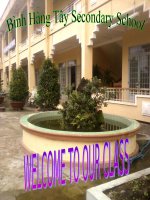
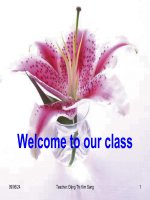
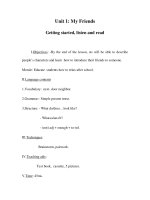
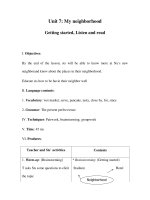
![unit 4[1][1]. Getting started and liten and read](https://media.store123doc.com/images/document/2014_07/15/medium_oka1382432025.jpg)

